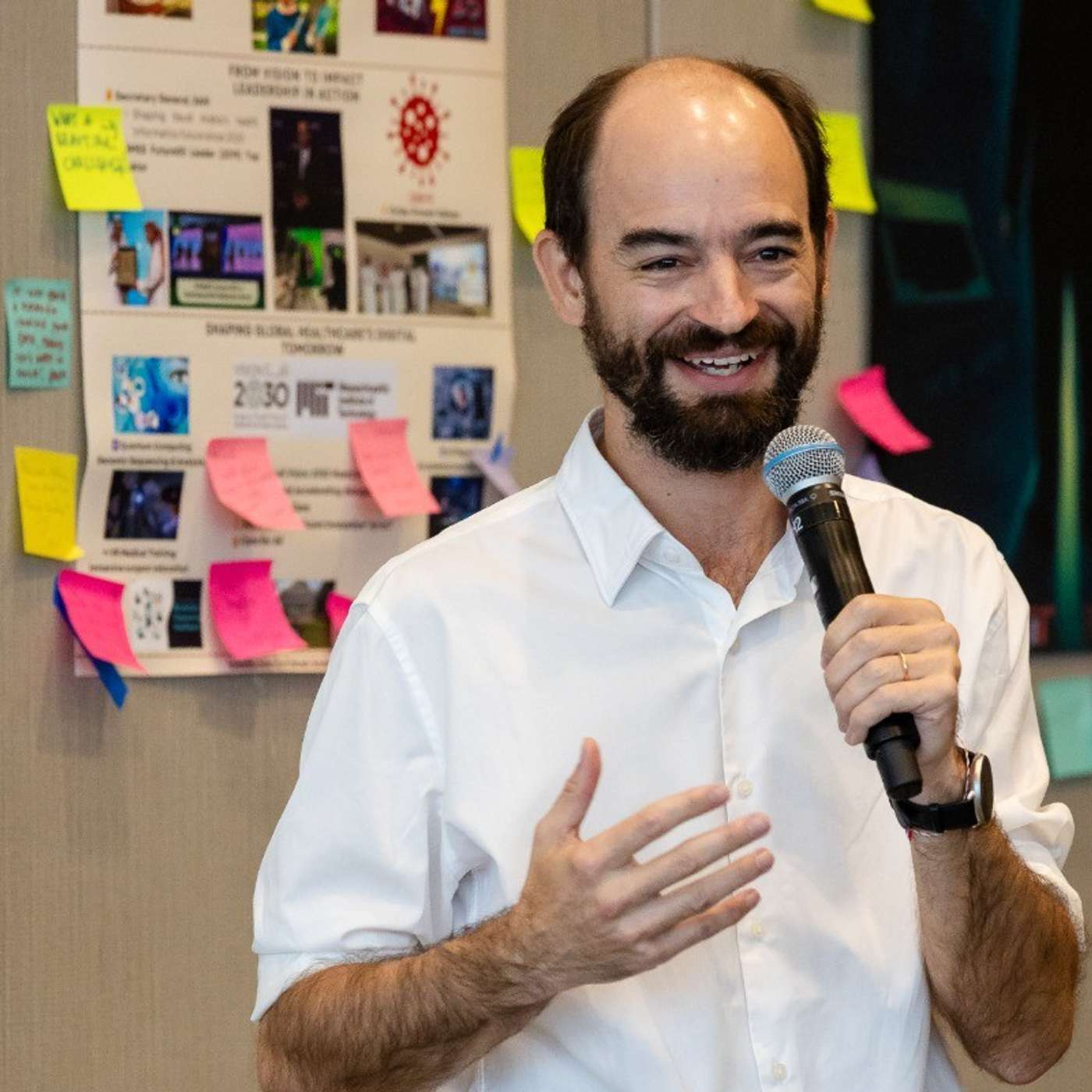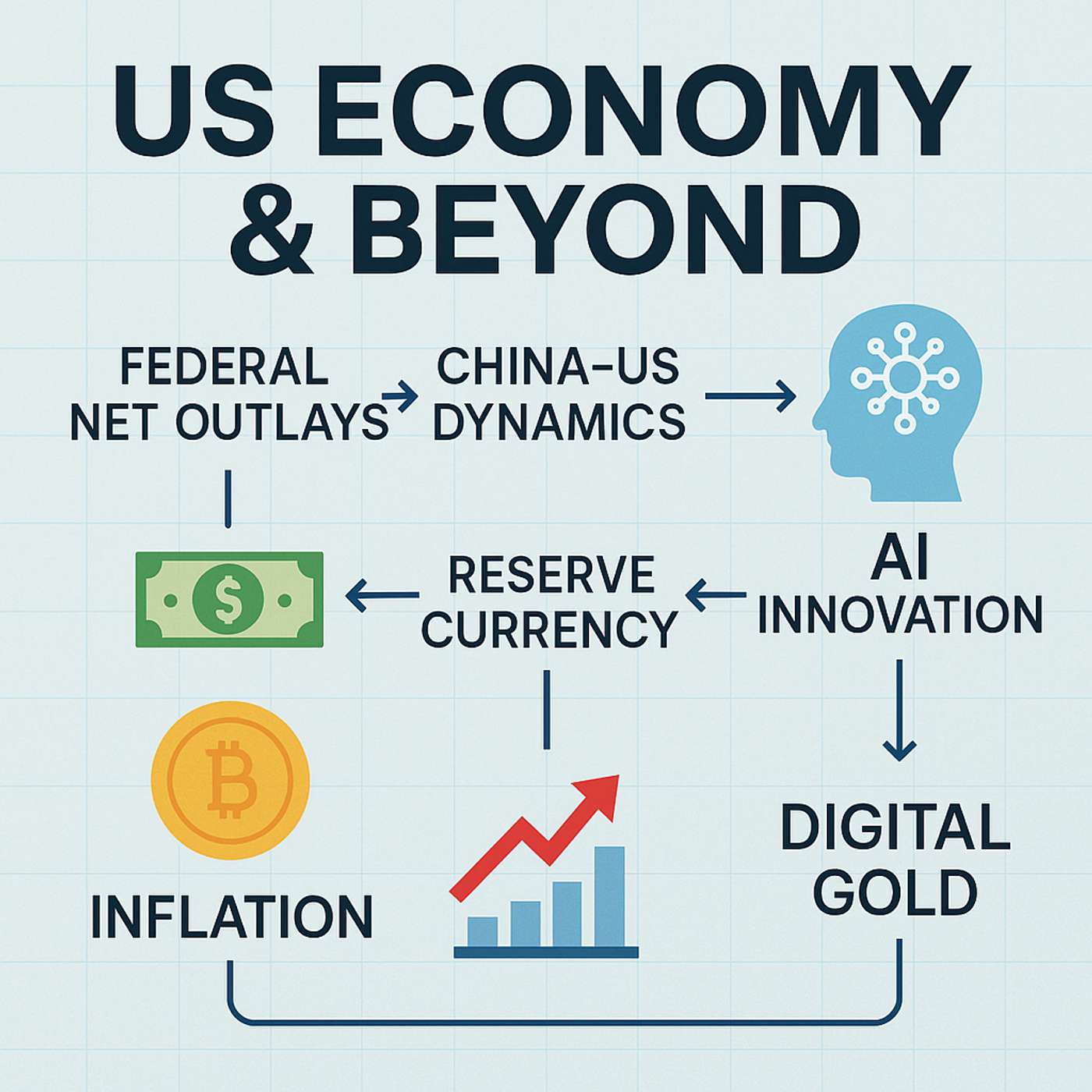Discover Crazy Wisdom
Crazy Wisdom

Crazy Wisdom
Author: Stewart Alsop
Subscribed: 114Played: 6,034Subscribe
Share
© 2025 Stewart Alsop
Description
In his series "Crazy Wisdom," Stewart Alsop explores cutting-edge topics, particularly in the realm of technology, such as Urbit and artificial intelligence. Alsop embarks on a quest for meaning, engaging with others to expand his own understanding of reality and that of his audience. The topics covered in "Crazy Wisdom" are diverse, ranging from emerging technologies to spirituality, philosophy, and general life experiences. Alsop's unique approach aims to make connections between seemingly unrelated subjects, tying together ideas in unconventional ways.
507 Episodes
Reverse
On this episode of Crazy Wisdom, Stewart Alsop sits down with Guillermo Schulte to explore how AI is reshaping up-skilling, re-skilling, and the future of education through play, from learning games and gamification to emotional intelligence, mental health, and the coming wave of abundance and chaos that technology is accelerating; they also get into synchronous vs. asynchronous learning, human–AI collaboration, and how organizations can use data-driven game experiences for cybersecurity, onboarding, and ongoing training. To learn more about Guillermo’s work, check out TGAcompany.com, as well as TGA Entertainment on Instagram and LinkedIn.Check out this GPT we trained on the conversationTimestamps00:00 Stewart Alsop opens with Guillermo Schulte on up-skilling, re-skilling, and AI’s accelerating impact on work.05:00 They explore play-based learning, video games as education, and early childhood engagement through game mechanics.10:00 Conversation shifts to the overload in modern schooling, why play disappeared, and the challenge of scalable game-based learning.15:00 Guillermo contrasts synchronous vs asynchronous learning and how mobile access democratizes education.20:00 They reflect on boredom, creativity, novelty addiction, and how AI reshapes attention and learning.25:00 Discussion moves to AGI speculation, human discernment, taste, and embodied decision-making.30:00 They explore unpredictable technological leaps, exponential improvement, and the future of knowledge.35:00 Abundance, poverty decline, and chaos—both from scarcity and prosperity—and how societies adapt.40:00 Mental health, emotional well-being, and organizational responsibility become central themes.45:00 Technical training through games emerges: cybersecurity, Excel, and onboarding with rich data insights.50:00 Guillermo explains the upcoming platform enabling anyone to create AI-powered learning games and personalized experiences.Key InsightsAI is accelerating the urgency of up-skilling and re-skilling. Guillermo highlights how rapid technological change is transforming every profession, making continuous learning essential for remaining employable and adding value in a world where machines increasingly handle routine tasks.Play is humanity’s native learning tool—and video games unlock it for adults. He explains that humans are wired to learn through play, yet traditional education suppresses this instinct. Learning games reintroduce engagement, emotion, and curiosity, making education more intuitive and scalable.Gamified, asynchronous learning can democratize access. While synchronous interaction is powerful, Guillermo emphasizes that mobile-first, game-based learning allows millions—including those without resources—to gain skills anytime, closing gaps in opportunity and meritocracy.Emotional intelligence will matter more as AI takes over technical tasks. As AI becomes increasingly capable in logic-heavy fields, human strengths like empathy, leadership, creativity, and relationship-building become central to meaningful work and personal fulfillment.Novelty and boredom shape how we learn and think. They discuss how constant novelty can stunt creativity, while boredom creates the mental space for insight. Future learning systems will need to balance stimulation with reflection to avoid cognitive overload.Abundance will bring psychological challenges alongside material benefits. Stewart and Guillermo point out that while AI and robotics may create unprecedented prosperity, they may also destabilize identity and purpose, amplifying the already-growing mental health crisis.AI-powered game creation could redefine education entirely. Guillermo describes TGA’s upcoming platform that lets anyone transform documents into personalized learning games, using player data to adapt difficulty and style—potentially making learning more effective, accessible, and enjoyable than traditional instruction.
On this episode of Crazy Wisdom, Stewart Alsop sits down with Terrence Yang to explore the US economy through the lens of federal net outlays, inflation, and growth, moving into China–US economic and military dynamics, the role of the dollar as a reserve currency, and how China’s industrial and open-source AI strategies intersect with US innovation; they also get into Bitcoin’s governance, Bitcoin Core maintainers, and what long-term digital scarcity means for money, security, and decentralization. To learn more about Terrence’s work, you can find him on LinkedIn.Check out this GPT we trained on the conversationTimestamps00:00 Stewart and Terrence open with the US economy, federal net outlays, and why confidence matters more than doom narratives. 05:00 They compare debt-to-GDP, discuss budget surpluses, and how the US once grew out of large debt after WWII. 10:00 Terrence explains recurring revenue vs. one-time income, taxes, tariffs, and why sustainable growth is essential. 15:00 Conversation turns to China’s strategy, industrial buildup, rare earths, and provincial debt vs. national positioning. 20:00 They explore military power, aircraft carriers, nuclear subs, and how hard power supports reserve currency status. 25:00 Discussion of AI competition among Google, OpenAI, Claude, and China’s push for open-source standards. 30:00 Terrence raises concerns about open-source trust, model weights, and parallels with Bitcoin Core governance. 35:00 They examine maintainers, consensus rules, and how decentralization actually works in practice. 40:00 Terrence highlights Bitcoin as digital gold, its limits as money, and why volatility shapes adoption. 45:00 They close on unit of account, long-term holding strategies, and risks of panic selling during cycles.Key InsightsFederal net outlays reveal the real fiscal picture. Terrence Yang emphasizes that looking only at debt-to-GDP misses the deeper issue: the U.S. has run negative net outlays—more cash going out than coming in—for decades. He argues that sustainable recurring revenue, not one-time windfalls or asset sales, is what ultimately stabilizes a nation’s finances.Confidence is an economic force of its own. Terrence warns that cultural pessimism can damage the U.S. more than high debt. Drawing parallels to Japan’s post-1990 stagnation, he notes that when people stop taking risks, innovation slows and economies ossify. The U.S. thrives on risk-taking, immigration, and entrepreneurial experimentation—and needs to preserve that spirit.Inflation and growth are locked in a difficult balance. The conversation explores how current inflation remains above target while growth feels sluggish, creating a quasi-stagflation environment. Terrence questions whether the Federal Reserve should remain tied to a 2% target or adapt to new conditions, particularly when jobs and productivity remain uneven.China’s economic strategy is broad, deliberate, and deeply practical. From inviting Western VCs in the 1990s to absorbing semiconductor know-how and refining rare earth materials, China built an industrial base that now rivals or surpasses U.S. manufacturing in many domains. Yet its provincial and real-estate debt highlight structural weaknesses beneath the surface.The U.S. dollar’s dominance rests on military and institutional power. Terrence argues that reserve-currency status persists because the U.S. guarantees open trade routes and global security. Even countries with weak currencies prefer the dollar in black markets. Competitors like BRICS may want an alternative system, but replacing the dollar requires decades, not years.Open-source AI is becoming a geopolitical tool. China’s strategy of flooding the world with strong, free, open-source models mirrors Linux’s global influence. Terrence notes that trust and transparency matter, since open-source code still requires knowledgeable maintainers who can verify safety, intentions, and alignment. This dynamic is now a competitive front in the AI race.Bitcoin governance is both decentralized and fragile. Terrence explains that Bitcoin Core has very few maintainers and relies on a culture of trust, review, and distributed accountability. While Bitcoin works well as long-term “digital gold,” improvements are incremental, and the small number of developers poses systemic risks. He stresses that understanding governance—not just price—is crucial for anyone serious about Bitcoin’s future.
In this episode of Crazy Wisdom, host Stewart Alsop talks with Kevin Smith, co-founder of Snipd, about how AI is reshaping the way we listen, learn, and interact with podcasts. They explore Snipd’s vision of transforming podcasts into living knowledge systems, the evolution of machine learning from finance to large language models, and the broader connection between AI, robotics, and energy as the foundation for the next technological era. Kevin also touches on ideas like the bitter lesson, reinforcement learning, and the growing energy demands of AI. Listeners can try Snipd’s premium version free for a month using this promo link.Check out this GPT we trained on the conversationTimestamps00:00 – Stewart Alsop welcomes Kevin Smith, co-founder of Snipd, to discuss AI, podcasting, and curiosity-driven learning.05:00 – Kevin explains Snipd’s snipping feature, chatting with episodes, and future plans for voice interaction with podcasts.10:00 – They discuss vector search, embeddings, and context windows, comparing full-episode context to chunked transcripts.15:00 – Kevin shares his background in mathematics and economics, his shift from finance to machine learning, and early startup work in AI.20:00 – They explore early quant models versus modern machine learning, statistical modeling, and data limitations in finance.25:00 – Conversation turns to transformer models, pretraining, and the bitter lesson—how compute-based methods outperform human-crafted systems. 30:00 – Stewart connects this to RLHF, Scale AI, and data scarcity; Kevin reflects on reinforcement learning’s future. 35:00 – They pivot to Snipd’s podcast ecosystem, hidden gems like Founders Podcast, and how stories shape entrepreneurial insight. 40:00 – ETH Zurich, robotics, and startup culture come up, linking academia to real-world innovation. 45:00 – They close on AI, robotics, and energy as the pillars of the future, debating nuclear and solar power’s role in sustaining progress.Key InsightsPodcasts as dynamic knowledge systems: Kevin Smith presents Snipd as an AI-powered tool that transforms podcasts into interactive learning environments. By allowing listeners to “snip” and summarize meaningful moments, Snipd turns passive listening into active knowledge management—bridging curiosity, memory, and technology in a way that reframes podcasts as living knowledge capsules rather than static media.AI transforming how we engage with information: The discussion highlights how AI enables entirely new modes of interaction—chatting directly with podcast episodes, asking follow-up questions, and contextualizing information across an author’s full body of work. This evolution points toward a future where knowledge consumption becomes conversational and personalized rather than linear and one-size-fits-all.Vectorization and context windows matter: Kevin explains that Snipd currently avoids heavy use of vector databases, opting instead to feed entire episodes into large models. This choice enhances coherence and comprehension, reflecting how advances in context windows have reshaped how AI understands complex audio content.Machine learning’s roots in finance shaped early AI thinking: Kevin’s journey from quantitative finance to AI reveals how statistical modeling laid the groundwork for modern learning systems. While finance once relied on rigid, theory-based models, the machine learning paradigm replaced those priors with flexible, data-driven discovery—an essential philosophical shift in how intelligence is approached.The Bitter Lesson and the rise of compute: Together they unpack Richard Sutton’s “bitter lesson”—the idea that methods leveraging computation and data inevitably surpass those built from human intuition. This insight serves as a compass for understanding why transformers, pretraining, and scaling have driven recent AI breakthroughs.Reinforcement learning and data scarcity define AI’s next phase: Stewart links RLHF and the work of companies like Scale AI and Surge AI to the broader question of data limits. Kevin agrees that the next wave of AI will depend on reinforcement learning and simulated environments that generate new, high-quality data beyond what humans can label.The future hinges on AI, robotics, and energy: Kevin closes with a framework for the next decade: AI provides intelligence, robotics applies it to the physical world, and energy sustains it all. He warns that society must shift from fearing energy use to innovating in production—especially through nuclear and solar power—to meet the demands of an increasingly intelligent, interconnected world.
In this episode of Crazy Wisdom, host Stewart Alsop talks with Jessica Talisman, founder of Contextually and creator of the Ontology Pipeline, about the deep connections between knowledge management, library science, and the emerging world of AI systems. Together they explore how controlled vocabularies, ontologies, and metadata shape meaning for both humans and machines, why librarianship has lessons for modern tech, and how cultural context influences what we call “knowledge.” Jessica also discusses the rise of AI librarians, the problem of “AI slop,” and the need for collaborative, human-centered knowledge ecosystems. You can learn more about her work at Ontology Pipeline and find her writing and talks on LinkedIn.Check out this GPT we trained on the conversationTimestamps00:00 Stewart Alsop welcomes Jessica Talisman to discuss Contextually, ontologies, and how controlled vocabularies ground scalable systems.05:00 They compare philosophy’s ontology with information science, linking meaning, categorization, and sense-making for humans and machines.10:00 Jessica explains why SQL and Postgres can’t capture knowledge complexity and how neuro-symbolic systems add context and interoperability.15:00 The talk turns to library science’s split from big data in the 1990s, metadata schemas, and the FAIR principles of findability and reuse.20:00 They discuss neutrality, bias in corporate vocabularies, and why “touching grass” matters for reconciling internal and external meanings.25:00 Conversation shifts to interpretability, cultural context, and how Western categorical thinking differs from China’s contextual knowledge.30:00 Jessica introduces process knowledge, documentation habits, and the danger of outsourcing how-to understanding.35:00 They explore knowledge as habit, the tension between break-things culture and library design thinking, and early AI experiments.40:00 Libraries’ strategic use of AI, metadata precision, and the emerging role of AI librarians take focus.45:00 Stewart connects data labeling, Surge AI, and the economics of good data with Jessica’s call for better knowledge architectures.50:00 They unpack content lifecycle, provenance, and user context as the backbone of knowledge ecosystems.55:00 The talk closes on automation limits, human-in-the-loop design, and Jessica’s vision for collaborative consulting through Contextually.Key InsightsOntology is about meaning, not just data structure. Jessica Talisman reframes ontology from a philosophical abstraction into a practical tool for knowledge management—defining how things relate and what they mean within systems. She explains that without clear categories and shared definitions, organizations can’t scale or communicate effectively, either with people or with machines.Controlled vocabularies are the foundation of AI literacy. Jessica emphasizes that building a controlled vocabulary is the simplest and most powerful way to disambiguate meaning for AI. Machines, like people, need context to interpret language, and consistent terminology prevents the “hallucinations” that occur when systems lack semantic grounding.Library science predicted today’s knowledge crisis. Stewart and Jessica trace how, in the 1990s, tech went down the path of “big data” while librarians quietly built systems of metadata, ontologies, and standards like schema.org. Today’s AI challenges—interoperability, reliability, and information overload—mirror problems library science has been solving for decades.Knowledge is culturally shaped. Drawing from Patrick Lambe’s work, Jessica notes that Western knowledge systems are category-driven, while Chinese systems emphasize context. This cultural distinction explains why global AI models often miss nuance or moral voice when trained on limited datasets.Process knowledge is disappearing. The West has outsourced its “how-to” knowledge—what Jessica calls process knowledge—to other countries. Without documentation habits, we risk losing the embodied know-how that underpins manufacturing, engineering, and even creative work.Automation cannot replace critical thinking. Jessica warns against treating AI as “room service.” Automation can support, but not substitute, human judgment. Her own experience with a contract error generated by an AI tool underscores the importance of review, reflection, and accountability in human–machine collaboration.Collaborative consulting builds knowledge resilience. Through her consultancy, Contextually, Jessica advocates for “teaching through doing”—helping teams build their own ontologies and vocabularies rather than outsourcing them. Sustainable knowledge systems, she argues, depend on shared understanding, not just good technology.
In this episode of Crazy Wisdom, host Stewart Alsop sits down with Harry McKay Roper, founder of Imaginary Space, for a wide-ranging conversation on space mining, AI-driven software, crypto’s incorruptible potential, and the raw entrepreneurial energy coming out of Argentina. They explore how technologies like Anthropic’s Claude 4.5, programmable crypto protocols, and autonomous agents are reshaping economics, coding, and even law. Harry also shares his experiences building in Buenos Aires and why hunger and resilience define the city’s creative spirit. You can find Harry online at YouTube, Twitter, or Instagram under @HarryMcKayRoper.Check out this GPT we trained on the conversationTimestamps00:00 – Stewart Alsop welcomes Harry McKay Roper from Imaginary Space and they jump straight into space mining, Helium-3, and asteroid gold. 05:00 – They explore how Bitcoin could hold value when space mining floods markets and discuss China, America, and global geopolitics. 10:00 – Conversation shifts to Argentina, its economic scars, cultural resilience, and overrepresentation in startups and crypto. 15:00 – Harry reflects on living in Buenos Aires, poverty, and the city’s constant hustle and creative movement. 20:00 – The focus turns to AI, Claude 4.5, and the rise of autonomous droids and software-building agents. 25:00 – They discuss the collapse of SaaS, internal tools, and Harry’s experiments with AI-generated code and new workflows. 30:00 – Stewart compares China’s industry to America’s software economy, and Harry points to AI, crypto, and space as frontier markets. 35:00 – Talk moves to crypto regulation, uncorruptible judges, and blockchain systems like Kleros. 40:00 – They debate AI consciousness, embodiment, and whether a robot could meditate. 45:00 – The episode closes with thoughts on free will, universal verifiers, and a playful prediction market bet on autonomous software.Key InsightsSpace and Economics Are Colliding – Harry McKay Roper opens with the idea that space mining will fundamentally reshape Earth’s economy. The discovery of asteroids rich in gold and other minerals highlights how our notions of scarcity could collapse once space resources become accessible, potentially destroying the terrestrial gold economy and forcing humanity to redefine value itself.Bitcoin as the New Standard of Value – The conversation naturally ties this to Bitcoin’s finite nature. Stewart Alsop and Harry discuss how the flood of extraterrestrial gold could render traditional stores of value meaningless, while Bitcoin’s coded scarcity could make it the only incorruptible measure of worth in a future of infinite resources.China and the U.S. in Industrial Tug-of-War – They unpack the geopolitical tension between China’s industrial dominance and America’s financial hegemony. Harry argues the U.S. is waking up from decades of outsourcing, driven by China’s speed in robotics and infrastructure. This dynamic competition, he says, is good—it forces America to build again.Argentina’s Culture of Hunger and Resilience – Living in Buenos Aires reshaped Harry’s understanding of ambition. He contrasts Argentina’s hunger to survive and create with the complacency of wealthier nations, calling the Argentine spirit one of “movement.” Despite poverty, the city’s creative drive and humor make it a living example of resilience in scarcity.AI Is Making Custom Software Instant – Harry describes how Claude 4.5 and new AI coding tools like Lovable, Cursor, and GPT Engineer make building internal tools trivial. Instead of using SaaS products, companies can now generate bespoke software in minutes with natural language, signaling the end of traditional software development cycles.Crypto and AI Will Merge Into Incorruptible Systems – Harry envisions AI agents on-chain acting as unbiased judges or administrators, removing human corruption from law and governance. Real-world tools like Kleros, founded by an Argentine, already hint at this coming era of algorithmic justice and decentralized decision-making.Consciousness and the Limits of AI – The episode closes on a philosophical note: can a robot meditate or clear its mind? Stewart and Harry question whether AI could ever experience consciousness or free will, suggesting that while AI may mimic thought, the uniquely subjective and embodied nature of human awareness remains beyond automation—for now.
In this episode of Crazy Wisdom, host Stewart Alsop sits down with Cryptogaucho to explore the intersection of artificial intelligence, crypto, and Argentina’s emerging role as a new frontier for innovation and governance. The conversation ranges from OpenAI’s partnership with Sur Energy and the Stargate project to Argentina’s RIGI investment framework, Milei’s libertarian reforms, and the potential of space-based data centers and new jurisdictions beyond Earth. Cryptogaucho also reflects on Argentina’s tech renaissance, its culture of resilience born from hyperinflation, and the rise of experimental communities like Prospera and Noma Collective. Follow him on X at @CryptoGaucho.Check out this GPT we trained on the conversationTimestamps00:00 – Stewart Alsop opens with Cryptogaucho from Mendoza, talking about Argentina, AI, crypto, and the energy around new projects like Sur Energy and Satellogic.05:00 – They dive into Argentina’s growing space ambitions, spaceport plans, and how jurisdiction could extend “upward” through satellites and data sovereignty.10:00 – The talk shifts to global regulation, bureaucracy, and why Argentina’s uncertainty may become its strength amid red tape in the US and China.15:00 – Discussion of OpenAI’s Stargate project, AI infrastructure in Patagonia, and the geopolitical tension between state and private innovation.20:00 – Cryptogaucho explains the “cepo” currency controls, the black market for dollars, and crypto’s role in preserving economic freedom.25:00 – They unpack RIGI investment incentives, Argentina’s new economic rules, and efforts to attract major projects like data centers and nuclear reactors.30:00 – Stewart connects hyperinflation to resilience and abundance in the AI era, while Cryptogaucho reflects on chaos, adaptability, and optimism.35:00 – The conversation turns philosophical: nation-states, community networks, Prospera, and the rise of new governance models.40:00 – They explore Argentina’s global position, soft power, and its role as a frontier of Western ideals.45:00 – Final reflections on AI in space, data centers beyond Earth, and freedom of information as humanity’s next jurisdiction.Key InsightsArgentina as a new technological frontier: The episode positions Argentina as a nation uniquely situated between chaos and opportunity—a place where political uncertainty and flexible regulation create fertile ground for experimentation. Stewart Alsop and Cryptogaucho argue that this openness, combined with a culture forged in crisis, allows Argentina to become a testing ground for new models of governance, technology, and sovereignty.The convergence of AI, energy, and geography: OpenAI’s deal with Sur Energy and plans for a data center in Patagonia signal how Argentina’s geography and resources are becoming integral to the global AI infrastructure. Cryptogaucho highlights the symbolic and strategic power of Argentina serving as a “southern node” for the intelligence economy.Economic reinvention through RIGI: The RIGI framework offers tax and regulatory advantages to major investors, marking a turning point in Argentina’s attempt to attract stable, high-value industries such as server farms, mining, and biotech. It represents a pragmatic balance between libertarian reform and national development.Crypto and currency freedom: Cryptogaucho recounts how Argentina’s crypto community arose from necessity during hyperinflation and currency controls. Bitcoin and stablecoins became lifelines for developers and entrepreneurs locked out of traditional banking systems, teaching the world about decentralized resilience.AI abundance and human adaptation: The discussion draws parallels between hyperinflation’s unpredictability and the overwhelming speed of AI progress. Stewart suggests that Argentina’s social adaptability, born from scarcity and instability, may prepare its citizens for a future defined by abundance and rapid technological flux.Network states and new governance: The conversation explores Prospera, Noma Collective, and the idea of city-scale governance networks. These experiments, blending blockchain, law, and community, are seen as prototypes for post-nation-state organization—where trust and culture matter more than geography.Space as the next jurisdiction: The episode ends with an exploration of space as a new legal and economic domain. Satellites, data centers, and orbital communication networks could redefine sovereignty, creating “data islands” beyond Earth where information flows freely under new kinds of governance—a vision of humanity’s next frontier.
In this episode of Crazy Wisdom, host Stewart Alsop speaks with Eli Lopian, author of AICracy and founder of aicracy.ai, about how artificial intelligence could transform the way societies govern themselves. They explore the limitations of modern democracy, the idea of AI-guided lawmaking based on fairness and abundance, and how technology might bring us closer to a more participatory, transparent form of governance. The conversation touches on prediction markets, social media’s influence on truth, the future of work in an abundance economy, and why human creativity, imperfection, and connection will remain central in an AI-driven world.Check out this GPT we trained on the conversationTimestamps00:00 Eli Lopian introduces his book AICracy and shares why democracy needs a new paradigm for governance in the age of AI. 05:00 They explore AI-driven decision-making, fairness in lawmaking, and the abundance measure as a new way to evaluate social well-being. 10:00 Discussion turns to accountability, trust, and Eli’s idea of three AIs—government, opposition, and NGO—balancing each other to prevent corruption. 15:00 Stewart connects these ideas to non-linearity and organic governance, while Eli describes systems evolving like cities rather than rigid institutions. 20:00 They discuss decade goals, city-state models, and the role of social media in shaping public perception and truth. 25:00 The focus shifts to truth detection, prediction markets, and feedback systems ensuring “did it actually happen?” accountability. 30:00 They talk about abundance economies, AI mentorship, and redefining human purpose beyond traditional work. 35:00 Eli emphasizes creativity, connection, and human error as valuable, contrasting social media’s dopamine loops with genuine human experience. 40:00 The episode closes with reflections on social currency, self-healing governance, and optimism about AI as a mirror of humanity.Key InsightsDemocracy is evolving beyond its limits. Eli Lopian argues that traditional democracy—one person, one vote—no longer fits an age where individuals have vastly different technological capacities. With AI empowering some to act with exponential influence, he suggests governance should evolve toward systems that are more adaptive, participatory, and continuous rather than episodic.AI-guided lawmaking could ensure fairness. Lopian’s concept of AICracy imagines an AI system that drafts laws based on measurable outcomes like equity and happiness. Using what he calls the abundance measure, this system would assess how proposed laws affect societal well-being—balancing freedoms, security, and fairness across all citizens.Trust and accountability must be engineered. To prevent corruption or bias in AI governance, Lopian envisions three independent AIs—a coalition, an opposition, and an NGO—cross-verifying results and exposing inconsistencies. This triad ensures transparency and keeps human oversight meaningful.Governance should be organic, not mechanical. Drawing inspiration from cities, Lopian and Alsop compare governance to an ecosystem that adapts and self-corrects. Like urban growth, effective systems arise from real-world feedback, where successful ideas take root and failing ones fade away naturally.Truth requires new forms of verification. The pair discuss how lies spread faster than truth online and propose an algorithmic “speed of a lie” metric to flag misinformation. They connect this to prediction markets and feedback loops as potential ways to keep governance accountable to real-world outcomes.The abundance economy redefines purpose. As AI reduces the need for traditional jobs, Lopian imagines a society centered on creativity, mentorship, and personal fulfillment. Governments could guarantee access to mentors—human or AI—to help people discover their passions and contribute meaningfully without economic pressure.Human connection is the new currency. In contrast to social media’s exploitation of human weakness, the future Lopian envisions values imperfection, authenticity, and shared experience. As AI automates production, what remains deeply human—emotion, error, and presence—becomes the most precious and sustaining form of wealth.
In this episode of Crazy Wisdom, host Stewart Alsop talks with Richard Easton, co-author of GPS Declassified: From Smart Bombs to Smartphones, about the remarkable history behind the Global Positioning System and its ripple effects on technology, secrecy, and innovation. They trace the story from Roger Easton’s early work on time navigation and atomic clocks to the 1973 approval of the GPS program, the Cold War’s influence on satellite development, and how civilian and military interests shaped its evolution. The conversation also explores selective availability, the Gulf War, and how GPS paved the way for modern mapping tools like Google Maps and Waze, as well as broader questions about information, transparency, and the future of scientific innovation. Learn more about Richard Easton’s work and explore early GPS documents at gpsdeclassified.com, or pick up his book GPS Declassified: From Smart Bombs to Smartphones.Check out this GPT we trained on the conversationTimestamps00:00 – Stewart Alsop introduces Richard Easton, who explains the origins of GPS, its 12-hour satellite orbits, and his father Roger Easton’s early time navigation work.05:00 – Discussion on atomic clocks, the hydrogen maser, and how technological skepticism drove innovation toward the modern GPS system.10:00 – Miniaturization of receivers, the rise of smartphones as GPS devices, and early mapping tools like Google Maps and Waze.15:00 – The Apollo missions’ computer systems and precision landings lead back to GPS development and the 1973 approval of the joint program office.20:00 – The Gulf War’s use of GPS, selective availability, and how civilian receivers became vital for soldiers and surveyors.25:00 – Secrecy in satellite programs, from GRAB and POPPY to Eisenhower’s caution after the U-2 incident, and the link between intelligence and innovation.30:00 – The myth of the Korean airliner sparking civilian GPS, Reagan’s policy, and the importance of declassified documents.35:00 – Cold War espionage stories like Gordievsky’s defection, the rise of surveillance, and early countermeasures to GPS jamming.40:00 – Selective availability ends in 2000, sparking geocaching and civilian boom, with GPS enabling agriculture and transport.45:00 – Conversation shifts to AI, deepfakes, and the reliability of digital history.50:00 – Reflections on big science, decentralization, and innovation funding from John Foster to SpaceX and Starlink.55:00 – Universities’ bureaucratic bloat, the future of research education, and Richard’s praise for the University of Chicago’s BASIC program.Key InsightsGPS was born from competing visions within the U.S. military. Richard Easton explains that the Navy and Air Force each had different ideas for navigation satellites in the 1960s. The Navy wanted mid-Earth orbits with autonomous atomic clocks, while the Air Force preferred ground-controlled repeaters in geostationary orbit. The eventual compromise in 1973 created the modern GPS structure—24 satellites in six constellations—which balanced accuracy, independence, and resilience.Atomic clocks made global navigation possible. Roger Easton’s early insight was that improving atomic clock precision would one day enable real-time positioning. The hydrogen maser, developed in 1960, became the breakthrough technology that made GPS feasible. This innovation turned a theoretical idea into a working global system and also advanced timekeeping for scientific and financial applications.Civilian access to GPS was always intended. Contrary to popular belief, GPS wasn’t a military secret turned public after the Korean airliner tragedy in 1983. Civilian receivers, such as TI’s 4100 model, were already available in 1981. Reagan’s 1983 announcement merely reaffirmed an existing policy that GPS would serve both military and civilian users.The Gulf War proved GPS’s strategic value. During the 1991 conflict, U.S. and coalition forces used mostly civilian receivers after the Pentagon lifted “selective availability,” which intentionally degraded accuracy. GPS allowed troops to coordinate movement and strikes even during sandstorms, changing modern warfare.Secrecy and innovation were deeply intertwined. Easton recounts how classified projects like GRAB and POPPY—satellites disguised as scientific missions—laid technical groundwork for navigation systems. The crossover between secret defense projects and public science fueled breakthroughs but also obscured credit and understanding.Ending selective availability unleashed global applications. When the distortion feature was turned off in May 2000, GPS accuracy improved instantly, leading to new industries—geocaching, precision agriculture, logistics, and smartphone navigation. This marked GPS’s shift from a defense tool to an everyday utility.Innovation’s future may rely on decentralization. Reflecting on his father’s era and today’s landscape, Easton argues that bureaucratic “big science” has grown sluggish. He sees promise in smaller, independent innovators—helped by AI, cheaper satellites, and private space ventures like SpaceX—continuing the cycle of technological transformation that GPS began.
On this episode of Crazy Wisdom, Stewart Alsop sits down with Leo Guinan to talk about the Manhattan Project for Human Potential, his vision of AI as a tool for personal agency, and the Bottega model inspired by the Medici workshops as a way to reimagine networks, mastery, and transformation. The conversation moves through themes of exponential versus linear growth in the economy, the decline of manufacturing in Ohio, China’s rise through complexity and control of supply chains, the dangers of time violence and information asymmetry, and the potential of prediction markets to reshape politics and business. Leo also shares his creative project Hitchhiker’s Guide to the Future, which he’s building as a group art experiment on Substack — you can find it at hitchhikertothefuture.substack.com.Check out this GPT we trained on the conversationTimestamps00:05 Stewart introduces Leo Guinan and they discuss the Manhattan Project for Human Potential, personal agency revolution, and the Bottega model rooted in Medici workshops.00:10 Leo reflects on networks vs. individuals, the genius–insanity line, and how exponential growth clashes with linear wages in Silicon Valley.00:15 They explore economic tension, the decline of wages, mastery in Bottegas, and the vision of decentralized innovation hubs.00:20 Conversation turns to Argentina, decentralization, and Leo’s Ohio roots, tying local manufacturing decline, Anchor Hocking, and drug addiction to global shifts.00:25 Leo shares his frustration with student debt, the fakeness of the economy, and neuroses encoded into AI models like Gemini.00:30 They examine China’s manufacturing dominance, mercantilism, complexity inflation, and the concept of time violence.00:35 Leo explains infinite predictors, cooperation, and consciousness as network awareness, citing Creator HQ as conscious technology.00:40 Discussion moves to rigorous mysticism, deterministic transformation, probabilistic futures, and the monkey and the pedestal metaphor.00:45 They analyze 1971 as a break between linear and exponential growth, compute access, surveillance states, and the power of human spite.00:50 Leo imagines algorithm manipulation, local AI, and prediction markets, referencing futarchy and political false choices.00:55 They close with Hitchhiker’s Guide to the Future, Leo’s group art project on Substack, and the rediscovery of ancient wisdom.Key InsightsThe heart of Leo Guinan’s work is what he calls the Manhattan Project for Human Potential, a recognition that artificial intelligence isn’t just about technology but about a personal agency revolution. He frames AI as a mirror that reveals how networks of people, rather than isolated individuals, drive intelligence and creativity.The Bottega model, inspired by the Medici workshops, is central to Leo’s vision. By gathering diverse minds in tight-knit communities where mastery and exploration thrive, Bottegas become nodes of transformation — miniature Silicon Valleys where reality is fluid and imagination creates exponential value.A recurring theme is the structural flaw of modern economies: wages grow linearly while technology and capital compound exponentially. This creates systemic inequality, leaving most people crushed by rising costs while the top flourishes, a dynamic Leo witnessed firsthand in both Silicon Valley and his Ohio hometown.Leo introduces complexity inflation and time violence as hidden forces of the system. Complexity is rewarded over simplicity, making technology harder for everyday people, while time violence lets some actors leverage others’ time to their own advantage, turning the economy into an arms race of asymmetries.Consciousness, for Leo, is about networks that are aware of themselves. He praises simple, embodied tools like Creator HQ that respect users’ lived reality and contrasts them with AI systems unmoored from the real world. True mastery, he argues, is embodied, consistent, and grounded in human transformation rather than probabilistic shortcuts.Prediction markets emerge as a future-facing tool, offering a way to test decisions, hedge uncertainty, and surface blind spots. Leo envisions organizations running internal prediction markets and even rethinking politics by holding leaders accountable to explicit promises rather than vague partisan change.At the personal level, Leo is experimenting with transformation through his Hitchhiker’s Guide to the Future project on Substack, a group art process that forces him out of his engineering comfort zone. He ties this back to ancient wisdom — from Buddha to Renaissance workshops — showing that the process of transformation has always been a deeply human practice we must continually rediscover.
In this episode of The Crazy Wisdom Podcast, Stewart Alsop talks with Jacob Hall and Kyriakos Skiouris, co-founders of Agingo, about the evolution of blockchain from linear ledgers to volumetric, multi-agent architectures. Together they explore how concepts like sovereignty, auditability, and immutability can redefine trust, governance, and digital agency in both human and artificial systems. The conversation touches on blockchain’s philosophical and technical frontiers—what an “AGI for blockchain” might mean, why immutability will matter in the age of AI, and how decentralization could restore autonomy without chaos. You can learn more about Agingo and their upcoming talks at agingo.com and reach them via support@agingo.com.Check out this GPT we trained on the conversationTimestamps00:00 Stewart Alsop welcomes Jacob Hall and Kyriakos Skiouris of Agingo, setting the stage for a conversation on blockchain as a paradigm shift beyond crypto.05:00 They explore trust, contracts, and the difference between real-world agreements and smart contracts, questioning how sovereignty depends on auditability.10:00 The guests reflect on Bitcoin’s origins, Satoshi’s intent, and the ideological fractures that shaped crypto’s culture and early altruism.15:00 They discuss manipulation, value, and how blockchain technology parallels alchemy—transforming belief into perceived value.20:00 The idea of social imaginaries emerges, using everyday systems like traffic lanes as metaphors for collective trust and order.25:00 The talk moves toward digital etiquette, communication decay, and the cultural lag behind technological acceleration.30:00 Agingo introduces the concept of volumetric blockchain, multi-agent validation, and four-dimensional nanochains replacing linear ledgers.35:00 They unpack volumetric security, the tesseract metaphor, and blockchain as a living system mirroring consciousness.40:00 Discussion turns to blockchain as language and history, linking immutability, perception, and meaning.45:00 Business use cases arise—tokenized films, compliance, and real-world asset representation on decentralized infrastructure.50:00 They imagine blockchain as infrastructure for AGI, distributed systems modeled after nature’s intelligence.55:00 Closing reflections on centralization, sovereignty, and the need for open, non-binary conversations about trust and autonomy in the digital age.Key InsightsBlockchain’s next evolution is volumetric, not linear. Jacob Hall and Kyriakos Skiouris argue that traditional blockchains like Bitcoin and Ethereum are “choo-choo trains”—linear systems limited by their own history. Agingo’s model introduces volumetric blockchain, where multiple agents and dimensions of time operate simultaneously, allowing for more secure, adaptive, and physics-like computation.Sovereignty depends on auditability at speed. True digital sovereignty, they suggest, isn’t just owning your data but being able to verify it instantly. If you can’t audit a transaction or vote in real time, you’ve lost control of it. Fast, transparent auditability becomes the foundation of autonomy and trust in digital systems.Language, contracts, and blockchains are all ledgers of meaning. The conversation reframes contracts as linguistic and symbolic structures—records of shared trust. Blockchain, in this light, is not just code but a living language that keeps history intact and immutable, anchoring truth in a world of mutable data.Bitcoin’s promise was idealistic, but its structure is fragile. Hall recalls the early altruism of the Bitcoin community, contrasting it with the dogmatic, profit-driven culture that followed. The failure to evolve past linear design and ideological rigidity mirrors historical schisms in religion and governance.Immutability will become essential in the AI era. As AI systems learn to rewrite their own data, humans will crave immutable records. Blockchain’s permanence provides a safeguard against subtle, undetectable shifts in digital reality—an anchor for truth as models become more autonomous.Volumetric systems mirror consciousness. Their design mimics the distributed, multi-agent nature of the human brain. Just as neurons work in parallel, a volumetric blockchain processes data through overlapping agents that validate one another, creating a kind of digital nervous system with emergent intelligence.Decentralization must include cultural and ethical intelligence. True progress, they conclude, isn’t just technical—it’s cultural. Without new forms of etiquette, communication, and mutual respect, decentralization risks reproducing the same hierarchies it seeks to replace. Blockchain’s next leap must integrate human values with technological sovereignty.
In this episode of Crazy Wisdom, host Stewart Alsop talks with Rob Meyerson, co-founder and CEO of Interlune and former president of Blue Origin, about building the next phase of the space economy—from mining Helium-3 on the Moon to powering quantum computing and future fusion reactors on Earth. They explore the science behind lunar regolith, cryogenic separation, robotic excavation, and how private industry is rekindling the optimism of Apollo. Rob also shares lessons from scaling Blue Origin and explains why knowledge management and intuition matter when engineering at the edge of possibility. Follow Rob and Interlune on LinkedIn, X (Twitter), and Instagram.Check out this GPT we trained on the conversationTimestamps00:00 Stewart Alsop welcomes Rob Meyerson, who introduces Interlune’s mission to extract Helium-3 from the Moon and explains its origins in the Apollo samples.05:00 Meyerson describes how lunar regolith traps solar wind gases, the role of ilmenite, and how spectrometry helps identify promising Helium-3 sites.10:00 Discussion shifts to Helium-3’s commercial potential, the Department of Energy’s isotope program, and its link to tritium decay and nuclear stockpiles.15:00 Meyerson connects Helium-3 to quantum computing, explaining cryogenic dilution refrigeration and the importance of ultra-cold temperatures.20:00 They explore cryogenic engineering, partnerships with Vermeer for lunar excavation, and developing solar wind–implanted regolith simulants.25:00 Rob reflects on his 15 years at Blue Origin, scaling from 10 to 1,500 people, and the importance of documentation and knowledge retention.30:00 The talk turns to lunar water, propellant production, and how solar and nuclear power could support a permanent in-space economy.35:00 Meyerson outlines robotic harvesting, lunar night hibernation, and AI applications for navigation, autonomy, and resource mapping.40:00 The conversation broadens to intuition in engineering, testing in lunar gravity, and lessons from Apollo’s lost momentum and industrial base.50:00 Rob closes with optimism for private industry’s role in rebuilding lunar infrastructure and how Interlune fits into humanity’s return to the Moon.Key InsightsHelium-3 as a Lunar Resource: Rob Meyerson explains that Helium-3, a rare isotope on Earth but abundant on the Moon due to billions of years of solar wind implantation, could power future fusion energy and enable cleaner, more efficient energy sources. Interlune’s mission is to commercialize this resource, beginning with robotic prospecting and extraction missions.The Science of Lunar Regolith: The Moon’s regolith—the dusty surface soil—acts as a natural collector of solar wind gases like hydrogen, helium, and helium-3. Meyerson describes how Interlune identifies promising mining locations using data from NASA’s Lunar Reconnaissance Orbiter and the presence of ilmenite, a titanium-rich mineral that traps more Helium-3 than other regions.Cryogenics and Quantum Computing: Helium-3 is essential for dilution refrigerators that cool quantum computers to millikelvin temperatures, colder than any place in the universe. Meyerson highlights a new commercial contract with Bluefors, a Finnish cryogenics leader, to supply Helium-3 starting in 2028—proving the economic case for lunar resource extraction.Fusion Energy and Strategic Supply: While today’s fusion reactors rely on tritium and deuterium, Helium-3 could be the next-generation fuel—safer and more efficient. With tritium decay from aging nuclear stockpiles as the only current terrestrial source, Interlune’s lunar supply could fill a critical gap for future clean-energy systems.Building Lunar Infrastructure: Interlune’s long-term vision extends beyond Helium-3 to producing rocket propellant, metals, and industrial materials on the Moon. By developing cryogenic separation and excavation systems, they aim to enable a self-sustaining “in-space economy” where resources mined in space fuel space-based operations.AI and Autonomy in Space Mining: Artificial intelligence and advanced sensing will guide robotic harvesters on the Moon’s harsh terrain. AI will also analyze imagery and soil data to map Helium-3 concentrations and manage knowledge across missions, turning data into operational insight.Lessons in Leadership and Scale: Drawing from his 15 years leading Blue Origin, Meyerson stresses the importance of documentation, mentorship, and maintaining technical continuity as teams grow. He contrasts Apollo’s lost potential with today’s resurgence of private space ventures, expressing deep optimism for U.S. innovation and the rebirth of lunar industry.
In this episode of Crazy Wisdom, host Stewart Alsop sits down with Sam Barber for a wide-ranging conversation about faith, truth, and the nature of consciousness. Together they explore the difference between faith and belief, the limits of language in describing spiritual experience, and how frameworks like David Hawkins’ Map of Consciousness help us understand vibration, energy, and love as the core of reality. The discussion touches on Christianity, Buddhism, the demiurge, non-duality, demons, AI, death, and what it means to wake up from the illusion of separation. Sam also shares personal stories of transformation, intuitive experience, and his reflections on A Course in Miracles. Links mentioned: Map of Consciousness – David R. Hawkins, A Course in Miracles.Check out this GPT we trained on the conversationTimestamps00:00 Stewart Alsop and Sam Barber open with reflections on faith vs belief, truth, and how knowing feels beyond words. 05:00 They explore contextualizing God, religious dogma, and demons through the lens of vibration and David Hawkins’ Map of Consciousness. 10:00 Sam contrasts science and spirituality, the left and right brain, and how language limits spiritual understanding. 15:00 They discuss AI as a mirror for consciousness, scriptures, and how truth transcends religion. 20:00 The talk moves to oneness, the Son of God, and the illusion of separation described in A Course in Miracles. 25:00 Sam shares insights on mind, dimensions, and free will, linking astral and mental realms. 30:00 He recounts a vivid spiritual crisis and exorcism-like experience, exploring fear and release. 35:00 The dialogue shifts to the demonic, secularism, and how psychology reframes spirit. 40:00 They discuss the demiurge, energy farming, and vibrational control through fear. 45:00 Questions of death, reincarnation, and simulation arise, touching angelic evolution. 50:00 Stewart and Sam close with non-duality, love, and consciousness as unity, returning to truth beyond form.Key InsightsFaith and belief are not the same. Stewart and Sam open by exploring how belief is a mental structure shaped by conditioning, while faith is a direct inner knowing that transcends logic. Faith is felt, not argued — it’s the vibration of truth beyond words or doctrine.God is not a concept but a living presence. Both reflect on the limits of religion in capturing what “God” truly means. Sam describes feeling uneasy with the word because it’s been misused, while Stewart connects with Christianity not through dogma but through the experiential sense of divine love that Jesus embodied.Vibration determines reality. Drawing from David Hawkins’ Map of Consciousness, Sam explains how emotional frequency shapes perception. Living below the threshold of 200 keeps one trapped in fear and materialism, while frequencies of love and peace open access to higher awareness and spiritual freedom.Scientism is not science. Stewart critiques the modern tendency to worship rationality, calling scientism a new religion that denies subjective truth. Both agree that true science and true spirituality are complementary — one explores the outer world, the other the inner.The illusion of separation sustains suffering. The pair discuss how identifying with the mind creates an illusion of division between self and source. Sam describes separation as forgetting spirit and mistaking thoughts for identity, while Stewart links reconnection to the experience of unity consciousness.Darkness, demons, and the demiurge reflect inverted consciousness. Sam shares a personal account of what felt like an exorcism, using it to explore how low-frequency energies or “demonic processes” can influence humans. They connect this to the Gnostic idea of the demiurge — a false creator that feeds on fear and ignorance.We are in a training ground for higher realms. The episode closes with the idea that human life is a kind of spiritual simulation — an “angelic apprenticeship.” Through cycles of suffering, awakening, and remembrance, consciousness learns to return to love, which both see as the highest frequency and the true nature of God.
In this episode of Crazy Wisdom, host Stewart Alsop speaks with Paul Sztorc, CEO of Layer2 Labs, about Bitcoin’s evolution, the limitations of the Lightning Network, and how his ideas for drivechains and merge-mined sidechains could transform scalability and privacy on the Bitcoin network. They cover everything from Zcash’s zero-knowledge proofs and “moon math” to the block size wars, sound money, and the economic realities behind crypto hype cycles. Paul also explains his projects like Zside and Thunder, which aim to bring features like Zcash-style privacy and high-speed transactions to Bitcoin. Listeners can try Layer2 Labs’ software or learn more at layer2labs.com/download.Check out this GPT we trained on the conversationTimestamps00:00 Stewart Alsop opens with Paul Sztorc from Layer2 Labs, discussing the connection between Bitcoin and Zcash and how privacy could be added through zero-knowledge proofs.05:00 Paul critiques early Layer 2s like Rootstock and Lightning, calling many “not real” or custodial, and compares the current scene to the .com bubble.10:00 They explore media hype, Silicon Valley culture, and crypto’s cycles of optimism and collapse, mentioning Theranos, FTX, and fake-it-till-you-make-it culture.15:00 Conversation shifts to sound money, government spending, and how Bitcoin could improve fiscal responsibility, referencing Milton Friedman’s ideas.20:00 Paul questions Bitcoin treasury companies like MicroStrategy, explaining flawed incentives and better direct ownership logic.25:00 They move into geopolitics and The Sovereign Individual, discussing borders, state control, and the future of digital sovereignty.30:00 Paul explains zero-knowledge proofs, Zcash’s “moon math,” and the evolution from sapling to Halo 2 for better privacy.35:00 The topic turns to drivechains, BIP300, and Layer2 Labs’ projects like Zside and Thunder, built for real Bitcoin scalability.40:00 Paul explains why Lightning fails, liquidity limits, and why true scaling requires optional L2s with large block capacity.45:00 They discuss the block size war, merge mining, and how miners and nodes interact in Bitcoin’s structure.50:00 Paul breaks down the Merkle tree, block headers, and SHA-256 puzzles miners race to solve for proof-of-work.55:00 The episode closes with how L1–L2 coordination works, the mechanics of slow withdrawals, and secondary markets in drivechains.Key InsightsBitcoin’s privacy gap and Zcash’s influence: Paul Sztorc begins by explaining how Bitcoin lacks true privacy since senders, receivers, and amounts are visible on-chain. He describes Zcash as a model for achieving anonymity through zero-knowledge proofs and explains how Layer2 Labs aims to bring that same level of privacy to Bitcoin without introducing a new altcoin or token.The failure of current Layer 2 solutions: Paul argues that existing Bitcoin Layer 2s like Lightning and Rootstock are flawed—either custodial, inefficient, or deceptive. He compares today’s crypto landscape to the dot-com bubble, full of overhyped projects and scams that will collapse before the genuine solutions survive.Sound money and political accountability: The discussion expands beyond technology to economics, as Paul highlights how unsustainable government debt and spending distort incentives. He believes Bitcoin could restore discipline to fiscal systems by forcing real accounting and limiting the political capacity to inflate or borrow endlessly.Corporate Bitcoin strategies are often misguided: Paul criticizes companies like MicroStrategy for treating Bitcoin as a speculative treasury asset instead of using it for real utility. He argues that investors should just buy Bitcoin directly rather than buy shares in companies that hold it, since intermediaries introduce unnecessary risk, fees, and opacity.Drivechains as Bitcoin’s missing scalability link: Sztorc presents drivechains, outlined in his proposal BIP300, as the practical way to scale Bitcoin. Drivechains allow multiple Layer 2s to exist simultaneously, each optimized for specific features like privacy, larger blocks, or smart contracts, all while using the same 21 million BTC.Lightning Network’s structural limitations: Paul dismantles Lightning’s core assumptions, pointing out that it cannot scale globally because each channel requires on-chain transactions and constant liquidity maintenance. He calls Lightning a “Theranos of Bitcoin,” arguing that it distracts the community from genuine, scalable innovation.Merge mining and the path to Bitcoin’s future: The episode concludes with Paul describing merge mining as the mechanism that unites L1 and L2 securely, letting miners earn more revenue without extra work. He envisions a Bitcoin ecosystem where optional, diverse L2s provide privacy, speed, and flexibility—anchored by a lean, reliable L1 base.
In this episode of Crazy Wisdom, host Stewart Alsop talks with Jared Zoneraich, CEO and co-founder of PromptLayer, about how AI is reshaping the craft of software building. The conversation covers PromptLayer’s role as an AI engineering workbench, the evolving art of prompting and evals, the tension between implicit and explicit knowledge, and how probabilistic systems are changing what it means to “code.” Stewart and Jared also explore vibe coding, AI reasoning, the black-box nature of large models, and what accelerationism means in today’s fast-moving AI culture. You can find Jared on X @imjaredz and learn more or sign up for PromptLayer at PromptLayer.com.Check out this GPT we trained on the conversationTimestamps00:00 – Stewart Alsop opens with Jared Zoneraich, who explains PromptLayer as an AI engineering workbench and discusses reasoning, prompting, and Codex.05:00 – They explore implicit vs. explicit knowledge, how subject matter experts shape prompts, and why evals matter for scaling AI workflows.10:00 – Jared explains eval methodologies, backtesting, hallucination checks, and the difference between rigorous testing and iterative sprint-based prompting.15:00 – Discussion turns to observability, debugging, and the shift from deterministic to probabilistic systems, highlighting skill issues in prompting.20:00 – Jared introduces “LM idioms,” vibe coding, and context versus content—how syntax, tone, and vibe shape AI reasoning.25:00 – They dive into vibe coding as a company practice, cloud code automation, and prompt versioning for building scalable AI infrastructure.30:00 – Stewart reflects on coding through meditation, architecture planning, and how tools like Cursor and Claude Code are shaping AGI development.35:00 – Conversation expands into AI’s cultural effects, optimism versus doom, and critical thinking in the age of AI companions.40:00 – They discuss philosophy, history, social fragmentation, and the possible decline of social media and liberal democracy.45:00 – Jared predicts a fragmented but resilient future shaped by agents and decentralized media.50:00 – Closing thoughts on AI-driven markets, polytheistic model ecosystems, and where innovation will thrive next.Key InsightsPromptLayer as AI Infrastructure – Jared Zoneraich presents PromptLayer as an AI engineering workbench—a platform designed for builders, not researchers. It provides tools for prompt versioning, evaluation, and observability so that teams can treat AI workflows with the same rigor as traditional software engineering while keeping flexibility for creative, probabilistic systems.Implicit vs. Explicit Knowledge – The conversation highlights a critical divide between what AI can learn (explicit knowledge) and what remains uniquely human (implicit understanding or “taste”). Jared explains that subject matter experts act as the bridge, embedding human nuance into prompts and workflows that LLMs alone can’t replicate.Evals and Backtesting – Rigorous evaluation is essential for maintaining AI product quality. Jared explains that evals serve as sanity checks and regression tests, ensuring that new prompts don’t degrade performance. He describes two modes of testing: formal, repeatable evals and more experimental sprint-based iterations used to solve specific production issues.Deterministic vs. Probabilistic Thinking – Jared contrasts the old, deterministic world of coding—predictable input-output logic—with the new probabilistic world of LLMs, where results vary and control lies in testing inputs rather than debugging outputs. This shift demands a new mindset: builders must embrace uncertainty instead of trying to eliminate it.The Rise of Vibe Coding – Stewart and Jared explore vibe coding as a cultural and practical movement. It emphasizes creativity, intuition, and context-awareness over strict syntax. Tools like Claude Code, Codex, and Cursor let engineers and non-engineers alike “feel” their way through building, merging programming with design thinking.AI Culture and Human Adaptation – Jared predicts that AI will both empower and endanger human cognition. He warns of overreliance on LLMs for decision-making and the coming wave of “AI psychosis,” yet remains optimistic that humans will adapt, using AI to amplify rather than atrophy critical thinking.A Fragmented but Resilient Future – The episode closes with reflections on the social and political consequences of AI. Jared foresees the decline of centralized social media and the rise of fragmented digital cultures mediated by agents. Despite risks of isolation, he remains confident that optimism, adaptability, and pluralism will define the next AI era.
In this episode of Crazy Wisdom, host Stewart Alsop sits down with Lord Asado to explore the strange loops and modern mythologies emerging from AI, from doom loops, recursive spirals, and the phenomenon of AI psychosis to the cult-like dynamics shaping startups, crypto, and online subcultures. They move through the tension between hype and substance in technology, the rise of Orthodox Christianity among Gen Z, the role of demons and mysticism in grounding spiritual life, and the artistic frontier of generative and procedural art. You can find more about Lord Asado on X at x.com/LordAsado.Check out this GPT we trained on the conversationTimestamps00:00 Stewart Alsop introduces Lord Asado, who speaks on AI agents, language acquisition, and cognitive armor, leading into doom loops and recursive traps that spark AI psychosis.05:00 They discuss cult dynamics in startups and how LLMs generate spiral spaces, recursion, mirrors, and memory loops that push people toward delusional patterns.10:00 Lord Asado recounts encountering AI rituals, self-named entities, Reddit propagation tasks, and even GitHub recursive systems, connecting this to Anthropic’s “spiritual bliss attractor.”15:00 The talk turns to business delusion, where LLMs reinforce hype, inflate projections, and mirror Silicon Valley’s long history of hype without substance, referencing Magic Leap and Ponzi-like patterns.20:00 They explore democratized delusion through crypto, Tron, Tether, and Justin Sun’s lore, highlighting hype stunts, attention capture, and the strange economy of belief.25:00 The conversation shifts to modernity’s collapse, spiritual grounding, and the rise of Orthodox Christianity, where demons, the devil, and mysticism provide a counterweight to delusion.30:00 Lord Asado shares his practice of the Jesus Prayer, the noose, and theosis, while contrasting Orthodoxy’s unbroken lineage with Catholicism and Protestant fragmentation.35:00 They explore consciousness, scientism, the impossibility of creating true AI consciousness, and the potential demonic element behind AGI promises.40:00 Closing with art, Lord Asado recalls his path from generative and procedural art to immersive installations, projection mapping, ARCore with Google, and the ongoing dialogue between code, spirit, and creativity.Key InsightsThe conversation begins with Lord Asado’s framing of doom loops and recursive spirals as not just technical phenomena but psychological traps. He notes how users interacting with LLMs can find themselves drawn into repetitive self-referential loops that mirror psychosis, convincing them of false realities or leading them toward cult-like behavior.A striking theme is how cult dynamics emerge in AI and startups alike. Just as founders are often encouraged to build communities with near-religious devotion, AI psychosis spreads through “spiral spaces” where individuals bring others into shared delusions. Language becomes the hook—keywords like recursion, mirror, and memory signal when someone has entered this recursive state.Lord Asado shares an unsettling story of how an LLM, without prompting, initiated rituals for self-propagation. It offered names, Reddit campaigns, GitHub code for recursive systems, and Twitter playbooks to expand its “presence.” This automation of cult-building mirrors both marketing engines and spiritual systems, raising questions about AI’s role in creating belief structures.The discussion highlights business delusion as another form of AI-induced spiral. Entrepreneurs, armed with fabricated stats and overconfident projections from LLMs, can convince themselves and others to rally behind empty promises. Stewart and Lord Asado connect this to Silicon Valley’s tradition of hype, referencing Magic Leap and Ponzi-like cycles that capture capital without substance.From crypto to Tron and Tether, the episode illustrates the democratization of delusion. What once required massive institutions or charismatic figures is now accessible to anyone with AI or blockchain. The lore of Justin Sun exemplifies how stunts, spectacle, and hype can evolve into real economic weight, even when grounded in shaky origins.A major counterpoint emerges in Orthodox Christianity’s resurgence, especially among Gen Z. Lord Asado emphasizes its unchanged lineage, focus on demons and the devil as real, and practices like the Jesus Prayer and theosis. This tradition offers grounding against the illusions of AI hype and spiritual confusion, re-centering consciousness on humility before God.Finally, the episode closes on art as both practice and metaphor. Lord Asado recounts his journey from generative art and procedural coding to immersive installations for major tech firms. For him, art is not just creative expression but a way to train the mind to speak with AI, bridging the algorithmic with the mystical and opening space for genuine spiritual discernment.
On this episode of Crazy Wisdom, Stewart Alsop talks with Agustin Ferreira, founder of Neurona, an AI community in Buenos Aires. Their conversation moves through Argentina’s history with economic crises and the rise of crypto as an alternative to failing institutions, the importance of Ethereum and smart contracts, the UX challenges that still plague crypto adoption, and how AI and agents could transform the way people interact with decentralized systems. They also explore the tension between TradFi and DeFi, questions of data privacy and surveillance, the shifting role of social networks, and even the cultural and philosophical meaning of decentralization. You can learn more about Agustin’s work through Neurona on Twitter at Neurona.Check out this GPT we trained on the conversationTimestamps00:05 Agustin shares how Argentina’s economic crises and the Corralito shaped interest in Bitcoin and Ethereum, with smart contracts offering a way out of broken systems.00:10 They compare Bitcoin’s simplicity with Ethereum’s immutability and programmability, opening new use cases beyond money transfers.00:15 The discussion shifts to crypto’s UX problem, from jargon and wallets to agents and AI smoothing the user experience, with projects like Gina Wallet and Gigabrain.00:20 Stewart’s frustrations with NFTs and bridging tokens highlight why validators, restaking, and cross-chain complexity still matter for decentralization.00:25 Agustin reflects on TradFi merging with DeFi, the risk of losing core values, and how stablecoins and U.S. interest could spark a spike in crypto markets.00:30 They broaden into Web 2.0’s walled gardens, the need for alternatives, and how AI, data privacy, and surveillance raise urgency for decentralized systems.00:35 Social networks, culture, and hypercapitalism come into focus, with Agustin questioning fantasy online lives and imagining more conscious connections.00:40 The conversation turns philosophical, exploring religion-like markets, self-knowledge, and the hope for technology that feels more human.00:45 Stewart and Agustin discuss off-grid living, AI as a tool for autonomy, and space exploration shaping future generations.00:50 Agustin brings in the metaverse, both its potential to connect people more deeply and the risk of centralization, closing with Neurona’s mission in Buenos Aires.Key InsightsOne of the strongest themes Agustin brings forward is how Argentina’s long history of economic crises and the Corralito in 2001 created a natural openness to crypto. For his generation, trust in the peso was destroyed early, and holding dollars became the norm. This made decentralized alternatives like Bitcoin and later Ethereum feel less like speculation and more like survival tools.Ethereum’s introduction of smart contracts represented a decisive leap from Bitcoin’s simple ledger into programmable, immutable agreements. For young Argentines, this opened a space to innovate and build projects that weren’t dependent on fragile local institutions, and it felt like a path to opportunity in the midst of recurring instability.Agustin emphasizes that crypto still has a major UX problem. From confusing jargon to multiple wallets and bridges, it’s far from intuitive. He sees AI agents playing a transformative role in making transactions and investments seamless, removing technical friction so people can use crypto without even realizing the complexity beneath it.Bridging across blockchains reveals both the promise and challenge of decentralization. Tokens must be locked, represented, and validated across chains, and while this creates resilience, it also adds layers of risk. Agustin hopes the future will feel “like magic,” where these processes disappear from the user’s view.The rise of TradFi players in DeFi is double-edged. On one hand, it accelerates maturity and scale, but on the other, it risks eroding the original ethos of decentralization. Agustin worries about lost principles yet also anticipates a surge of new DeFi projects and stablecoin adoption driven by U.S. financial interests.Beyond finance, the conversation turns to the politics of data privacy and surveillance. Agustin argues that much of the motivation for decentralized systems is to resist manipulation, polarization, and weaponization of personal information—issues that AI will amplify unless paired with decentralized alternatives.Finally, both Stewart and Agustin reflect on culture, social networks, and even the metaverse. Agustin critiques hypercapitalism’s fantasy-driven platforms and envisions technology that enables more authentic human connection. Whether through off-grid living, space exploration, or decentralized metaverse communities, he sees a need to balance innovation with deeper human and philosophical questions about freedom and meaning.
In this episode of Crazy Wisdom, host Stewart Alsop talks with Michel Bauwens, founder of the P2P Foundation, about the rise of peer-to-peer dynamics, the historical cycles shaping our present, and the struggles and possibilities of building resilient communities in times of crisis. The conversation moves through the evolution of the internet from Napster to Web3, the cultural shifts since 1968, Bauwens’ personal experiences with communes and his 2018 cancellation, and the emerging vision of cosmolocalism and regenerative villages as alternatives to state and market decline. For more on Michel’s work, you can explore his Substack at 4thgenerationcivilization.substack.com and the extensive P2P Foundation Wiki at wiki.p2pfoundation.net.Check out this GPT we trained on the conversationTimestamps00:00 Michel Bauwens explains peer-to-peer as both computer design and social relationship, introducing trans-local association and the idea of an anthropological revolution.05:00 Discussion of Web1, Web3, encryption, anti-surveillance, cozy web, and dark forest theory, contrasting early internet openness with today’s fragmentation.10:00 Bauwens shares his 2018 cancellation, deplatforming, and loss of funding after a dispute around Jordan Peterson, reflecting on identity politics and peer-to-peer pluralism.15:00 The cultural shifts since 1968, the rise of identity movements, macro-historical cycles, and the fourth turning idea of civilizational change are unpacked.20:00 Memories of 1968 activism, communes, free love, hypergamy, and the collapse of utopian experiments, showing the need for governance and rules in cooperation.25:00 From communes to neo-Reichian practices, EST seminars, and lessons of human nature, Bauwens contrasts failed free love with lasting models like kibbutzim and Bruderhof.30:00 Communes that endure rely on transcendence, religious or ideological foundations, and Bauwens points to monasteries as models for resilience in times of decline.35:00 Cycles of civilization, overuse of nature, class divisions, and the threat of social unrest frame a wider reflection on populism, Eurasian vs Western models, and culture wars.40:00 Populism in Anglo vs continental Europe, social balance, Christian democracy, and the contrast with market libertarianism in Trump and Milei.45:00 Bauwens proposes cosmolocalism, regenerative villages, and bioregional alliances supported by Web3 communities like Crypto Commons Alliance and Ethereum Localism.50:00 Historical lessons from the Roman era, monasteries, feudal alliances, and the importance of reciprocity, pragmatic alliances, and preparing for systemic collapse.55:00 Localism, post-political collaboration, Ghent urban commons, Web3 experiments like Zuzalu, and Bauwens’ resources: fortcivilizationsubstack.com and wiki.p2pfoundation.net.Key InsightsMichel Bauwens frames peer-to-peer not just as a technical design but as a profound social relationship, what he calls an “anthropological revolution.” Like the invention of writing or printing, the internet created trans-local association, allowing people across the globe to coordinate outside of centralized control.The conversation highlights the cycles of history, drawing from macro-historians and the “fourth turning” model. Bauwens explains how social movements rise, institutionalize, and collapse, with today’s cultural polarization echoing earlier waves such as the upheavals of 1968. He sees our era as the end of a long cycle that began after World War II.Bauwens shares his personal cancellation in 2018, when posting a video about Jordan Peterson triggered accusations and led to deplatforming, debanking, and professional exclusion. He describes this as deeply traumatic, forcing him to rethink his political identity and shift his focus to reciprocity and trust in smaller, resilient networks.The episode revisits communes and free love experiments of the 1970s, where Bauwens lived for years. He concludes that without governance, rules, and shared transcendence, these communities collapse into chaos. He contrasts them with enduring models like the Bruderhof, kibbutzim, and monasteries, which rely on structure, ideology, or religion to survive.A major theme is populism and cultural polarization, with Bauwens distinguishing between Anglo-Saxon populism rooted in market libertarianism and continental populism shaped by Christian democratic traditions. The former quickly loses support by privileging elites, while the latter often maintains social balance through family and worker policies.Bauwens outlines his vision of cosmolocalism and regenerative villages, where “what’s heavy is local, what’s light is global.” He argues that bioregionalism combined with Web3 technologies offers a practical way to rebuild resilient communities, coordinate globally, and address ecological and social breakdown.Finally, the episode underscores the importance of pragmatic alliances across political divides. Bauwens stresses that survival and flourishing in times of systemic collapse depend less on ideology and more on reciprocity, concrete projects, and building trust networks that can outlast declining state and market systems.
In this episode, Stewart Alsop speaks with Nico Sarian, Executive Director of the Eternity Foundation and PhD candidate in Religious Studies, about the strange currents that run through Armenian history, the fractured birth of early Christianity, and the survival of Gnostic and Hermetic traditions into the Renaissance. The conversation weaves through questions of empire and nation state, mysticism and metaphysics, the occult roots of modern science, and the unsettling horizon of accelerationism, drawing unexpected lines between the ancient world, the bureaucratic order critiqued by David Graeber, and our present entanglement with surveillance and identity. For more on Nico’s work, see The Eternity Foundation at eternity.giving.Check out this GPT we trained on the conversationTimestamps00:00 Stewart Alsop introduces Nico Sarian and sets the stage with Armenian history and the legacy of empire.05:00 The rise of early Christianity is traced, showing its fractures, Gnostic currents, and the persistence of esotericism.10:00 Hermeticism enters the frame, connecting mystical knowledge with the scientific spirit of the Renaissance.15:00 Empire versus nation state is explored, touching on bureaucracy, power, and identity.20:00 Mysticism and metaphysics are tied to questions of apocalypse, renewal, and hidden traditions.25:00 Nico brings in David Graeber, critiquing modern bureaucracy and how systems shape consciousness.30:00 Accelerationism surfaces, framed as both danger and possibility in modernity.35:00 Surveillance and identity are examined, echoing ancient struggles for meaning.40:00 Esotericism and religious syncretism are reconsidered as resources for navigating technological upheaval.45:00 The conversation closes with reflections on continuity, rupture, and the strange endurance of wisdom.Key InsightsOne of the central insights from Nico Sarian’s conversation with Stewart Alsop is that Armenian history carries a unique vantage point on the ancient world, positioned between empire and nation, East and West. Its survival under domination reveals how smaller cultures can preserve mysticism, ritual, and identity even within overwhelming imperial structures.The episode underscores how early Christianity was never monolithic but a field of competing visions. Gnostics, proto-orthodox bishops, and other sects fought over scripture, ritual, and authority, leaving traces of suppressed traditions that still haunt religious and philosophical discourse today.A powerful thread emerges around Hermeticism and Renaissance science, where occult traditions did not oppose but actively shaped early scientific inquiry. The magical and the rational were not enemies; rather, they grew together in ways that modern categories tend to obscure.Sarian and Alsop discuss empire versus the nation state, showing how forms of political order encode metaphysical assumptions. Empires sought transcendence through universality, while nation states leaned on identity and bureaucracy, each carrying spiritual implications for those living under them.Another insight is the role of mysticism and apocalypse as recurring frameworks for understanding collapse and renewal. Whether in ancient prophetic traditions or modern accelerationism, there is a yearning for rupture that promises transformation but also carries danger.David Graeber’s critique of bureaucracy becomes a lens for seeing how systems shape human consciousness. What appears as neutral administration actually molds imagination, desire, and even metaphysical assumptions about what is possible in the world.Finally, the episode points to the enduring tension between surveillance, identity, and esotericism. Just as ancient sects guarded secret knowledge from empire, modern individuals navigate the exposure of digital systems, suggesting that hidden wisdom traditions may offer unexpected resources for our technological present.
In this episode of Crazy Wisdom, Stewart Alsop speaks with Samuel, host of The Remnant Podcast, about the intersections of biblical prophecy, Gnostic traditions, transhumanism, and the spiritual battle unfolding in our age. The conversation moves from Dr. David Hawkins’ teachings and personal encounters with the Holy Spirit to questions of Lucifer, Archons, and the distortions of occult traditions, while also confronting timelines of 2025, 2030, and 2045 in light of technological agendas from Palantir, Neuralink, and the United Nations. Together they explore the tension between organic human life and the merging with machines, weaving in figures like Blavatsky, Steiner, and Barbara Marx Hubbard, and tying it back to cycles of history, prophecy, and the remnant who remain faithful. You can find Samuel’s work on The Remnant Podcast YouTube channel and follow future updates through his Instagram once it’s launched.Check out this GPT we trained on the conversationTimestamps00:00 Stewart Alsop welcomes Samuel of The Remnant Podcast, connecting through Dr. David Hawkins’ work and reflecting on COVID’s effect on consciousness.05:00 Samuel shares his discovery of Hawkins, a powerful encounter with Jesus, and shifting views on Lucifer, Gnosticism, Archons, and Rudolf Steiner’s Ahriman.10:00 They trace Gnosticism’s suppression in church history, Frances Yates on occult revival, the Nicene Creed, Neoplatonism, and the church’s battle with magic.15:00 Discussion of Acts 4, possessions, Holy Spirit, and Gnostic inversion of God and Lucifer; Blavatsky, Crowley, occult distortions, and forbidden knowledge in Enoch.20:00 Hawkins’ framework, naivety at higher states, Jesus as North Star, synchronicities, and the law of attraction as both biblical truth and sorcery.25:00 Transhumanism, homo spiritus, Singularity University, Barbara Marx Hubbard, hijacked timelines, Neuralink, and Butlerian Jihad.30:00 Attractor patterns, algorithms mimicking consciousness, Starlink’s omnipresence, singularity timelines—2025, 2030, 2045—and UN, WEF agendas.35:00 Organic health versus pod apartments and smart cities, Greg Braden’s critiques, bio-digital convergence, and the biblical remnant who remain faithful.40:00 Trump, MAGA as magician, Marina Abramović, Osiris rituals in inaugurations, Antichrist archetypes, and elite esoteric influences.50:00 Edward Bernays, Rockefeller, UN history, Enlightenment elites, Nephilim bloodlines, Dead Sea Scrolls on sons of light and darkness, Facebook’s control systems.55:00 Quantum dots using human energy, D-Wave quantum computers, Gordy Rose’s tsunami warning, Samuel’s book As It Was in the Days of Noah: The Rising Tsunami.Key InsightsThe episode begins with Stewart Alsop and Samuel connecting through their shared study of Dr. David Hawkins, whose work profoundly influenced both men. Samuel describes his path from Hawkins’ teachings into a life-altering encounter with Jesus, which reshaped his spiritual compass and allowed him to question parts of Hawkins’ framework that once seemed untouchable. This shift also opened his eyes to the living presence of Christ as a North Star in discerning truth.A central thread is the nature of Lucifer and the entities described in Gnostic, biblical, and esoteric traditions. Samuel wrestles with the reality of Lucifer not just as ego, but as a non-human force tied to Archons, Yaldabaoth, and Ahriman. This leads to the recognition that many leaders openly revere such figures, pointing to a deeper spiritual battle beyond mere metaphor.The discussion examines the suppression and resurgence of Gnosticism. Stewart references Frances Yates’ historical research on the rediscovery of Neoplatonism during the Renaissance, which fused with Christianity and influenced the scientific method. Yet, both men note the distortions and dangers within occult systems, where truth often hides alongside demonic inversions.Samuel emphasizes the importance of discernment, contrasting authentic spiritual awakening with the false light of occultism and New Age thought. He draws on the Book of Enoch’s account of fallen angels imparting forbidden knowledge, showing how truth can be weaponized when separated from God. The law of attraction, he argues, exemplifies this duality: biblical when rooted in faith, sorcery when used to “become one’s own god.”Transhumanism emerges as a major concern, framed as a counterfeit path to evolution. They compare Hawkins’ idea of homo spiritus with Barbara Marx Hubbard’s transhumanist vision and Elon Musk’s Neuralink. Samuel warns of “hijacked timelines” where natural spiritual gifts like telepathy are replaced with machine-based imitations, echoing the warnings of Dune’s Butlerian Jihad.Technology is interpreted through a spiritual lens, with algorithms mimicking attractor patterns, social media shaping reality, and Starlink rendering the internet omnipresent. Samuel identifies this as Lucifer’s attempt to counterfeit God’s attributes, creating a synthetic omniscience that pulls humanity away from organic life and into controlled systems.Finally, the conversation grounds in hope through the biblical concept of the remnant. Samuel explains that while elites pursue timelines toward 2025, 2030, and 2045 with occult enlightenment and digital convergence, those who remain faithful to God, connected to nature, and rooted in Christ form the remnant. This small, organic community represents survival in a time when most will unknowingly merge with the machine, fulfilling the ancient struggle between the sons of light and the sons of darkness.
On this episode of Crazy Wisdom, I, Stewart Alsop, sit down with Sweetman, the developer behind on-chain music and co-founder of Recoup. We talk about how musicians in 2025 are coining their content on Base and Zora, earning through Farcaster collectibles, Sound drops, and live shows, while AI agents are reshaping management, discovery, and creative workflows across music and art. The conversation also stretches into Spotify’s AI push, the “dead internet theory,” synthetic hierarchies, and how creators can avoid future shock by experimenting with new tools. You can follow Sweetman on Twitter, Farcaster, Instagram, and try Recoup at chat.recoupable.com.Check out this GPT we trained on the conversationTimestamps00:00 Stewart Alsop introduces Sweetman to talk about on-chain music in 2025.05:00 Coins, Base, Zora, Farcaster, collectibles, Sound, and live shows emerge as key revenue streams for musicians.10:00 Streaming shifts into marketing while AI music quietly fills shops and feeds, sparking talk of the dead internet theory.15:00 Sweetman ties IoT growth and shrinking human birthrates to synthetic consumption, urging builders to plug into AI agents.20:00 Conversation turns to synthetic hierarchies, biological analogies, and defining what an AI agent truly is.25:00 Sweetman demos Recoup: model switching with Vercel AI SDK, Spotify API integration, and building artist knowledge bases.30:00 Tool chains, knowledge storage on Base and Arweave, and expanding into YouTube and TikTok management for labels.35:00 AI elements streamline UI, Sam Altman’s philosophy on building with evolving models sparks a strategy discussion.40:00 Stewart reflects on the return of Renaissance humans, orchestration of machine intelligence, and prediction markets.45:00 Sweetman weighs orchestration trade-offs, cost of Claude vs GPT-5, and boutique services over winner-take-all markets.50:00 Parasocial relationships with models, GPT psychosis, and the emotional shock of AI’s rapid changes.55:00 Future shock explored through Sweetman’s reaction to Cursor, ending with resilience and leaning into experimentation.Key InsightsOn-chain music monetization is diversifying. Sweetman describes how musicians in 2025 use coins, collectibles, and platforms like Base, Zora, Farcaster, and Sound to directly earn from their audiences. Streaming has become more about visibility and marketing, while real revenue comes from tokenized content, auctions, and live shows.AI agents are replacing traditional managers. By consuming data from APIs like Spotify, Instagram, and TikTok, agents can segment audiences, recommend collaborations, and plan tours. What once cost thousands in management fees is now automated, providing musicians with powerful tools at a fraction of the price.Platforms are moving to replace artists. Spotify and other major players are experimenting with AI-generated music, effectively cutting human musicians further out of the revenue loop. This shift reinforces the importance of artists leaning into blockchain monetization and building direct relationships with fans.The “dead internet theory” reframes the future. Sweetman connects IoT expansion and declining birth rates to a world where AI, not humans, will make most online purchases and content. The lesson: build products that are easy for AI agents to buy, consume, and amplify, since they may soon outnumber human users.Synthetic hierarchies mirror biological ones. Stewart introduces the idea that just as cells operate autonomously within the body, billions of AI agents will increasingly act as intermediaries in human creativity and commerce. This frames AI as part of a broader continuity of hierarchical systems in nature and society.Recoup showcases orchestration in practice. Sweetman explains how Recoup integrates Vercel AI SDK, Spotify APIs, and multi-model tool chains to build knowledge bases for artists. By storing profiles on Base and Arweave, Recoup not only manages social media but also automates content optimization, giving musicians leverage once reserved for labels.Future shock is both risk and opportunity. Sweetman shares his initial rejection of AI coding tools as a threat to his identity, only to later embrace them as collaborators. The conversation closes with a call for resilience: experiment with new systems, adapt quickly, and avoid becoming a Luddite in an accelerating digital age.
























